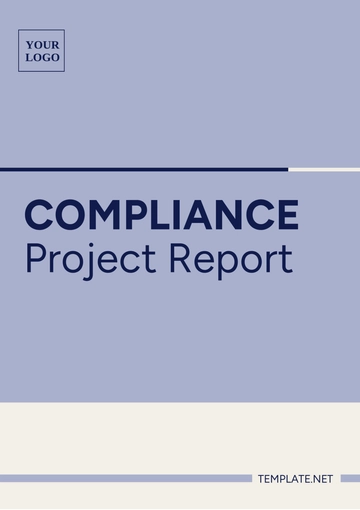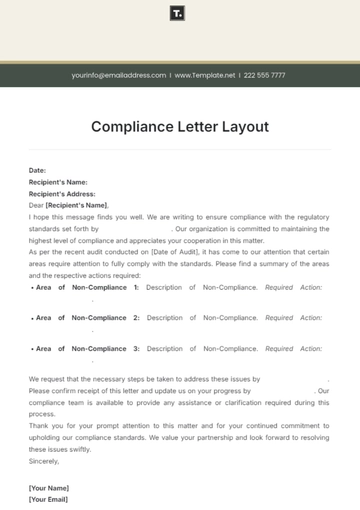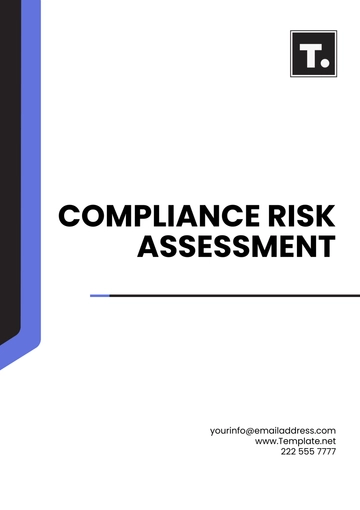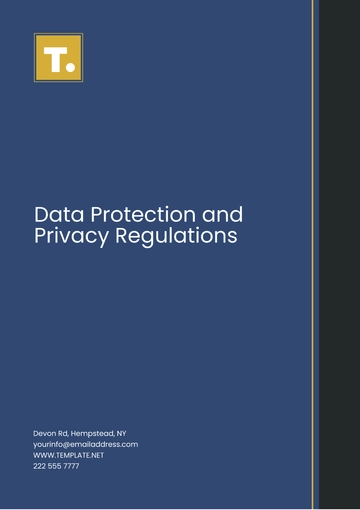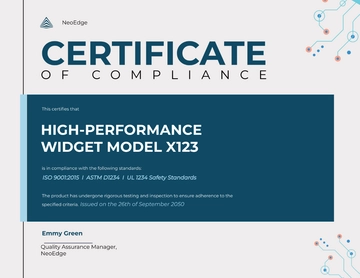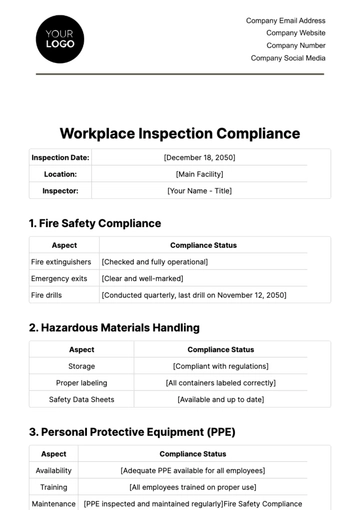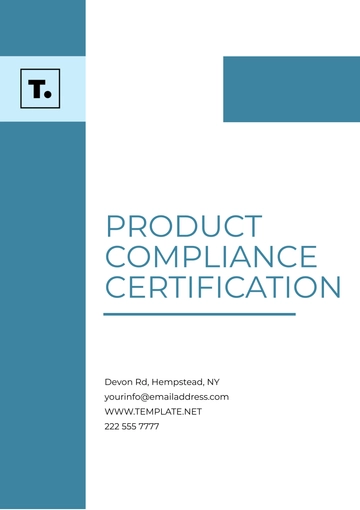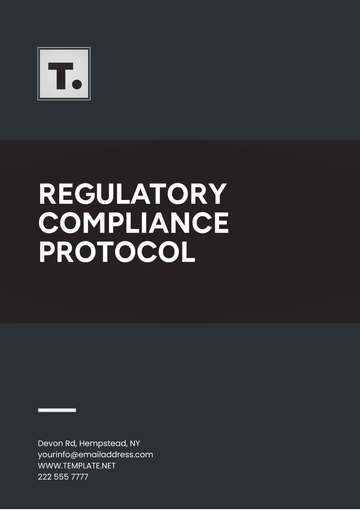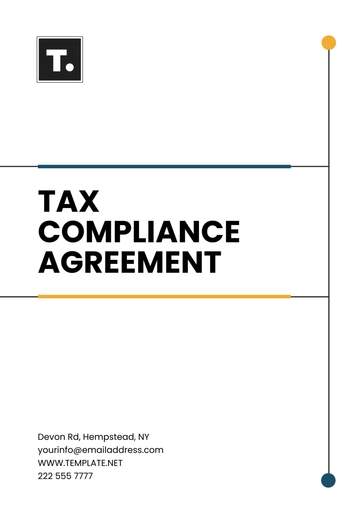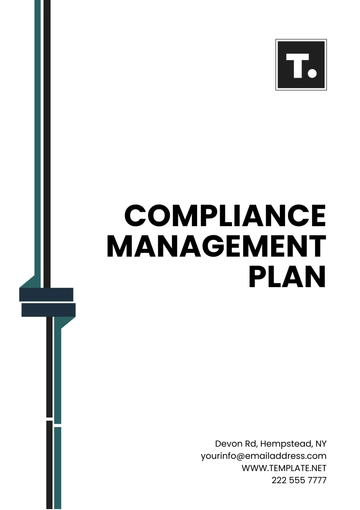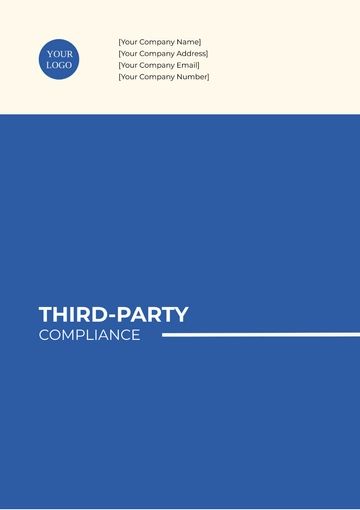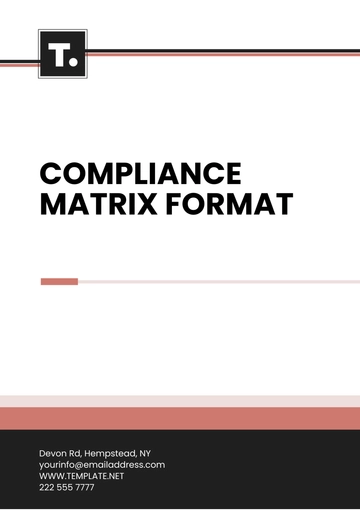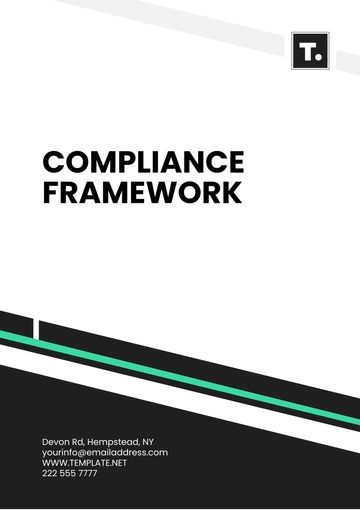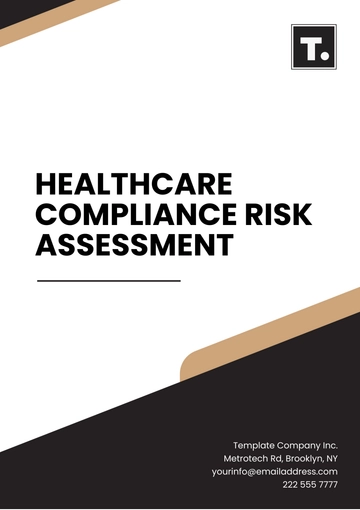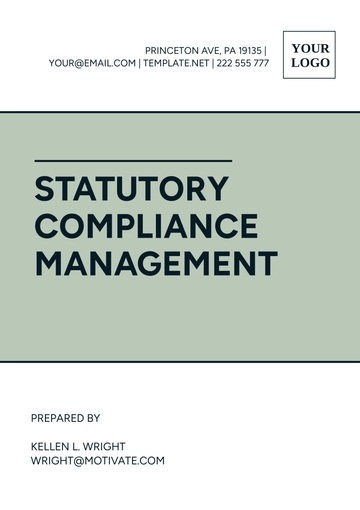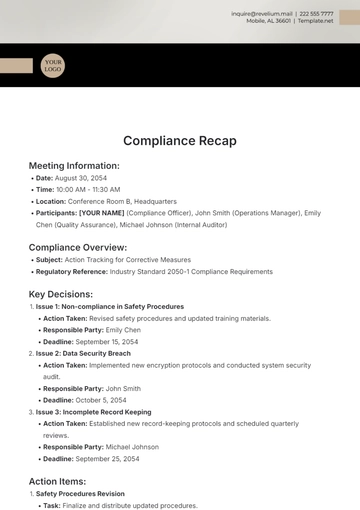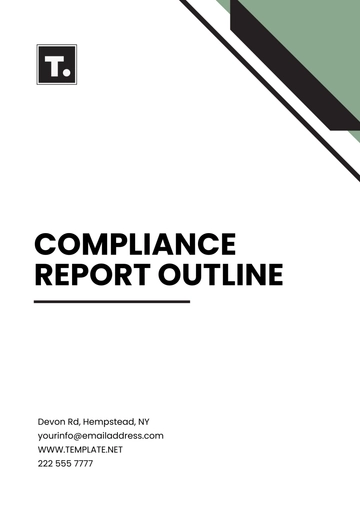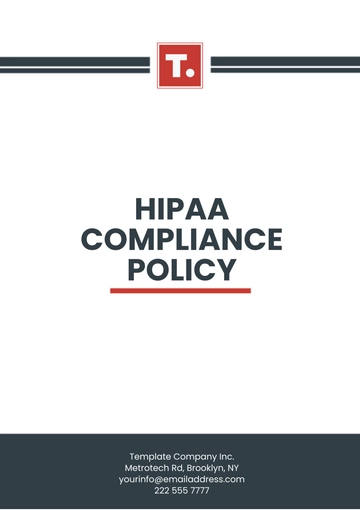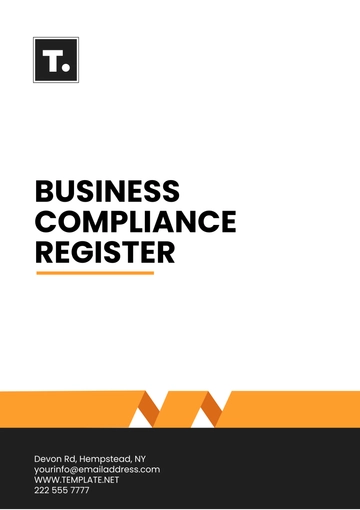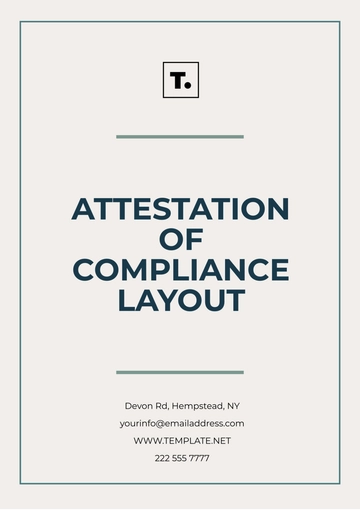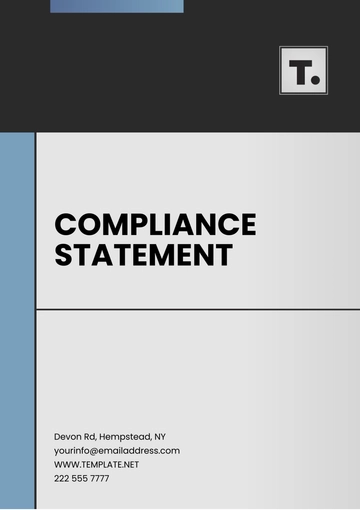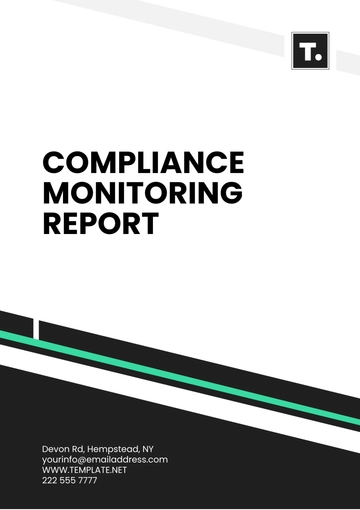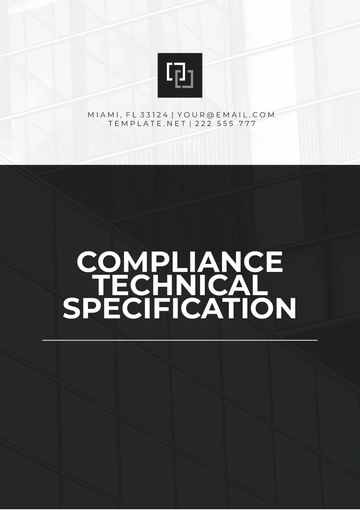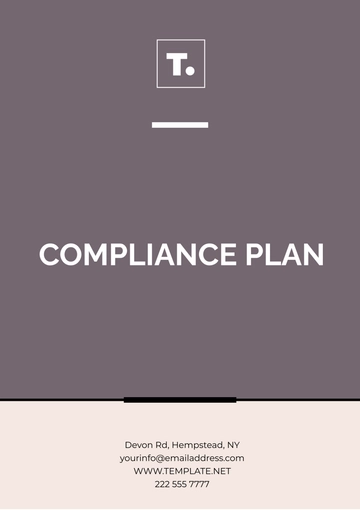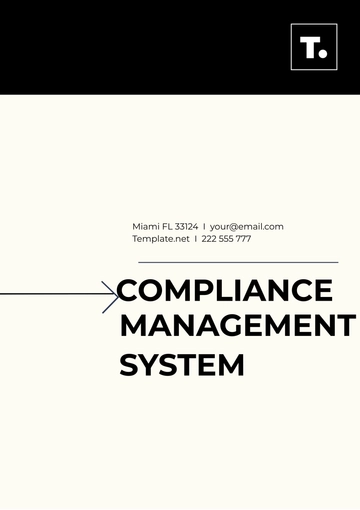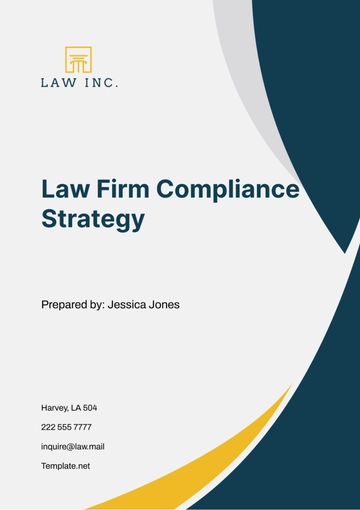Free Operations Quality Standards Compliance Guide
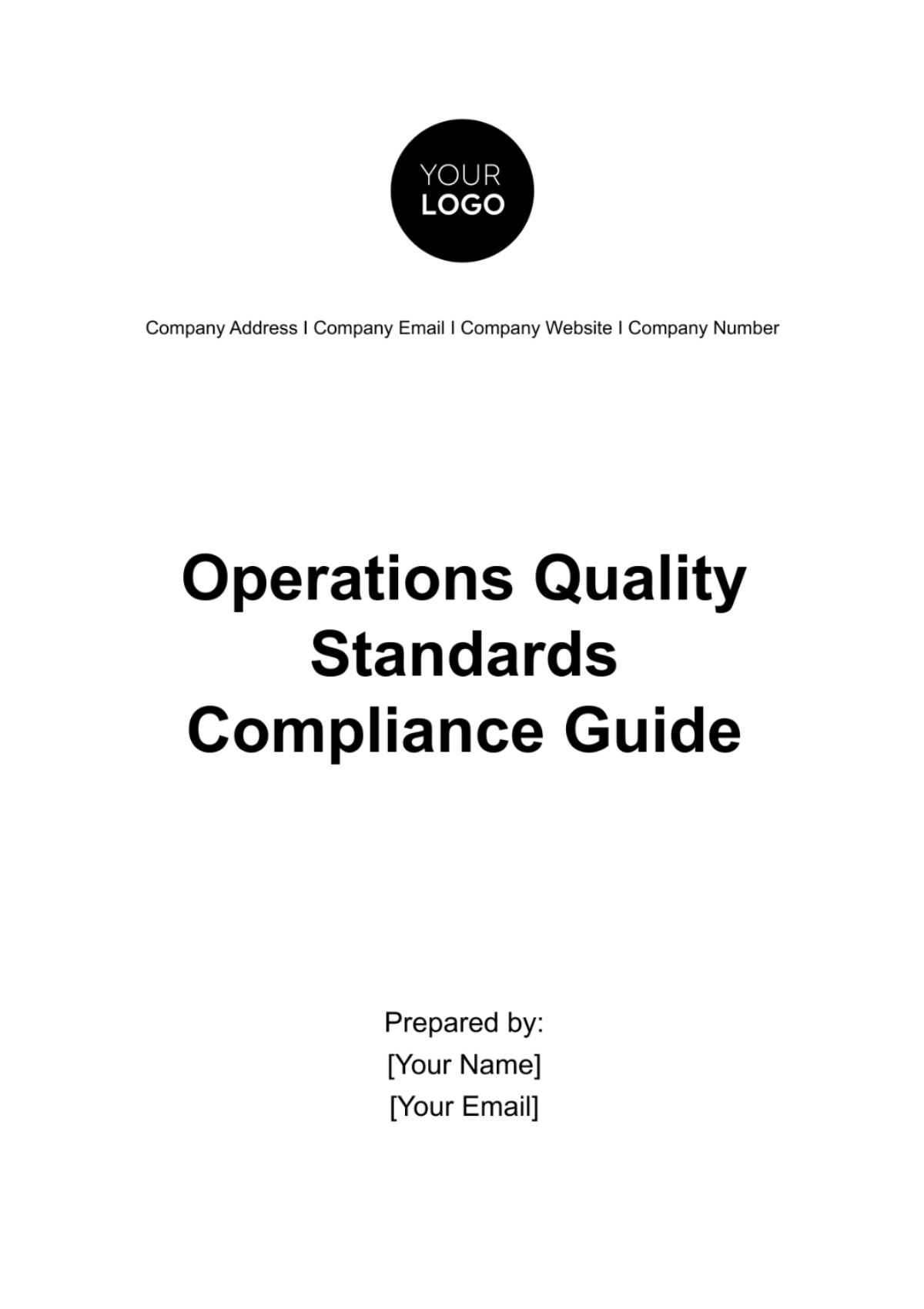
I. Introduction
A. Purpose of the Guide
The Operations Quality Standards Compliance Guide serves as a comprehensive resource to ensure adherence to quality standards and regulatory requirements within our organization's operations. It aims to establish a standardized approach to quality management, fostering consistency, efficiency, and continuous improvement across all departments and processes.
B. Scope and Applicability
This guide applies to all departments and personnel involved in the design, manufacturing, testing, and distribution of electronic devices at [Your Company Name]. It encompasses all aspects of quality assurance, including product design, production processes, supplier management, and customer service, to ensure the delivery of high-quality products that meet or exceed customer expectations.
C. Definitions and Acronyms
QMS (Quality Management System): A set of policies, procedures, and processes for achieving quality objectives and ensuring compliance with quality standards and regulations.
CAPA (Corrective and Preventive Action): Systematic actions taken to identify, address, and prevent the recurrence of non-conformities or quality issues.
NCR (Non-Conformance Report): Document used to report instances of non-conformance or deviation from quality standards.
KPI (Key Performance Indicator): Quantifiable measures used to evaluate the performance and effectiveness of quality management processes.
II. Regulatory Framework
A. Overview of Relevant Regulatory Requirements
Our operations comply with a range of regulatory requirements and industry standards to ensure the safety, reliability, and compliance of our products. These include international standards such as ISO 9001:2015 for quality management systems and industry-specific regulations such as the RoHS Directive for electronic products.
B. Compliance Obligations and Standards
ISO 9001:2015 Quality Management System: Specifies requirements for establishing, implementing, maintaining, and continually improving a QMS.
RoHS Directive (2011/65/EU): Restricts the use of certain hazardous substances in electrical and electronic equipment to protect human health and the environment.
III. Quality Management System
A. Description of the Quality Management System (QMS)
[Your Company Name] has established a robust QMS to ensure the consistent delivery of high-quality products and services. The QMS encompasses policies, procedures, and processes that govern all aspects of quality management, including quality planning, control, assurance, and improvement.
B. Roles and Responsibilities
Roles and responsibilities within the QMS are clearly defined to ensure accountability and effectiveness.
Role | Responsibilities |
|---|---|
Quality Manager | Oversee QMS implementation and compliance |
Production Manager | Ensure adherence to quality standards in manufacturing |
Quality Assurance | Conduct inspections and audits to maintain quality |
Production Operators | Follow standard operating procedures for quality control |
C. Document Control Procedures
Effective document control procedures are essential to ensure the integrity, accessibility, and traceability of quality-related documents. All documents, including policies, procedures, work instructions, and forms, are centrally managed and controlled according to established procedures. This ensures that the latest revisions are available to relevant personnel and that obsolete documents are promptly removed from circulation.
IV. Quality Control Processes
A. Product/Service Inspection Procedures
To maintain product quality, comprehensive inspection procedures are implemented at various stages of the manufacturing process. Incoming materials are inspected for compliance with specifications, and finished products undergo rigorous inspection and testing to ensure they meet quality standards before being released to customers.
B. Testing Methods and Protocols
Testing methods and protocols are established based on industry best practices and regulatory requirements. These include visual inspection, functional testing, environmental testing, and reliability testing. Test procedures are documented in detail to ensure consistency and repeatability.
C. Non-Conformance Management Procedures
In the event of a non-conformance or deviation from quality standards, a formal non-conformance report (NCR) is initiated. The NCR documents the nature of the non-conformance, its impact, and proposed corrective and preventive actions. Corrective actions are implemented to address the immediate issue, while preventive actions are taken to prevent recurrence.
V. Compliance Monitoring and Reporting
A. Internal Audits and Inspections
Internal audits are conducted regularly to assess the effectiveness of the QMS and ensure compliance with regulatory requirements and internal policies. Audits are planned, documented, and carried out by qualified personnel, and findings are reported to management for review and action.
B. Reporting Requirements
Quality performance metrics, including defect rates, customer complaints, and audit findings, are monitored and reported regularly to management. This enables timely identification of trends and issues, facilitating prompt corrective action and continuous improvement.
C. Corrective and Preventive Action (CAPA) Processes
CAPA processes are integral to maintaining the effectiveness of the QMS and driving continuous improvement. When non-conformances or opportunities for improvement are identified, corrective and preventive actions are initiated, documented, and tracked to resolution. This ensures that root causes are addressed, and measures are implemented to prevent recurrence.
VI. Training and Education
A. Training Needs Assessment
To ensure that training efforts are targeted and effective, [Your Company Name] conducts a thorough assessment of training needs. This assessment considers factors such as job roles, responsibilities, skill levels, and performance gaps identified through performance evaluations and feedback mechanisms. A matrix of training needs is developed, outlining required training for each job role and competency level. This matrix serves as a roadmap for planning and prioritizing training initiatives to address critical skill gaps and ensure alignment with organizational goals.
B. Training Programs and Materials
[Your Company Name] offers a variety of training programs and materials to cater to diverse learning needs and preferences. These include instructor-led training sessions, online courses, workshops, and on-the-job training modules. Training materials are developed in-house by subject matter experts and instructional designers, ensuring relevance, accuracy, and alignment with organizational objectives. Additionally, interactive and multimedia elements are incorporated into training materials to enhance engagement and knowledge retention among employees.
C. Evaluation of Training Effectiveness
To measure the impact and effectiveness of training programs, [Your Company Name] employs a comprehensive evaluation process. This process includes pre-training assessments to gauge baseline knowledge, post-training evaluations to assess learning outcomes, and follow-up assessments to measure knowledge retention and application on the job. Feedback from trainees and supervisors is collected through surveys and performance reviews, providing valuable insights into the effectiveness of training initiatives and areas for improvement. Based on evaluation results, adjustments are made to training programs to optimize effectiveness and ensure continuous improvement.
VII. Documentation and Record Keeping
A. Documentation Requirements
[Your Company Name] maintains a comprehensive set of quality-related documents to support its operations and ensure compliance with regulatory requirements. These documents include policies, procedures, work instructions, forms, specifications, and records of quality activities. Document templates are standardized and maintained centrally to ensure consistency and accuracy across the organization. Additionally, document metadata, such as revision history, approval status, and expiration dates, are recorded to facilitate document control and traceability.
B. Record Keeping Procedures
Effective record keeping procedures are essential to ensure the integrity, accessibility, and reliability of quality records. [Your Company Name] maintains records of inspections, tests, audits, corrective actions, and other quality-related activities in a centralized electronic repository. Records are organized, indexed, and archived according to established procedures to facilitate retrieval and traceability. Regular audits are conducted to verify the completeness and accuracy of records and address any discrepancies or gaps identified.
C. Document Retention and Archiving Policies
[Your Company Name] adheres to document retention and archiving policies to ensure compliance with regulatory requirements and facilitate efficient records management. These policies specify the retention periods for different types of records based on regulatory requirements, industry standards, and business needs. Records are archived securely using electronic storage systems with access controls, encryption, and backup mechanisms to protect against loss, tampering, or unauthorized access. Additionally, records are periodically reviewed and purged in accordance with established retention schedules to minimize storage costs and mitigate legal risks.
VIII. Continuous Improvement
A. Process Improvement Initiatives
[Your Company Name] is committed to driving continuous improvement in its operations through proactive process improvement initiatives. Cross-functional teams are formed to identify opportunities for improvement, analyze root causes of issues, and develop and implement action plans to address them. Continuous improvement projects are prioritized based on their potential impact on quality, customer satisfaction, cost savings, and other key performance indicators. Progress and outcomes of improvement initiatives are tracked, monitored, and reported to senior management to ensure accountability and transparency.
B. Root Cause Analysis Procedures
Root cause analysis (RCA) is a systematic approach used by [Your Company Name] to identify underlying causes of quality issues and prevent their recurrence. When quality problems arise, RCA teams are assembled to investigate the issue, collect relevant data, and analyze contributing factors using tools such as fishbone diagrams, 5 Whys, and Pareto analysis. By identifying the root causes of problems, [Your Company Name] can implement targeted corrective and preventive actions to address underlying issues and prevent similar issues from occurring in the future.
C. Monitoring Key Performance Indicators (KPIs)
[Your Company Name] monitors a set of key performance indicators (KPIs) to assess the effectiveness of its quality management system and track progress towards quality objectives. These KPIs include metrics such as defect rates, customer satisfaction scores, on-time delivery performance, and process efficiency indicators.
Key Performance Indicator | Description | Measurement Method | Target Value |
|---|---|---|---|
Defect Rate | Percentage of defective products | Statistical Analysis | < 1% |
Customer Satisfaction | |||
On-time Delivery | |||
Process Efficiency |
KPI data is collected, analyzed, and reported regularly to management to provide insight into the performance of quality processes, identify areas for improvement, and drive decision-making. By monitoring KPIs, [Your Company Name] can identify trends, anticipate potential issues, and take proactive measures to maintain and enhance product quality and customer satisfaction.
IX. Supplier and Vendor Management
A. Supplier Qualification and Evaluation Criteria
[Your Company Name] implements rigorous supplier qualification and evaluation criteria to ensure that suppliers meet quality, reliability, and regulatory requirements.
Qualification/Evaluation Criteria | Description |
|---|---|
Product Quality | Assessment of the supplier's ability to consistently deliver products that meet specified requirements. |
Manufacturing Capabilities | Evaluation of the supplier's manufacturing processes, capacity, technology, and equipment. |
Financial Stability | Assessment of the supplier's financial health, including profitability, liquidity, and solvency. |
Compliance with Ethical Standards | Verification of the supplier's adherence to ethical business practices and corporate social responsibility. |
Environmental Compliance | Evaluation of the supplier's environmental management practices and compliance with environmental regulations. |
Regulatory Compliance | Verification of the supplier's compliance with relevant industry regulations and standards. |
Suppliers are evaluated based on predefined scoring criteria, and only those that meet or exceed minimum requirements are approved for use.
B. Contractual Requirements
Supplier agreements and contracts include specific quality assurance provisions to ensure that suppliers adhere to [Your Company Name]'s quality standards and requirements.
Contractual Requirement | Description |
|---|---|
Product Specifications | Detailed specifications for products or components, including dimensions, materials, performance characteristics, and quality requirements. |
Quality Control Processes | Requirements for implementing and maintaining quality control processes, including inspection, testing, and validation procedures. |
Delivery Schedule | Agreed-upon schedule for delivery of products or components, including lead times, shipment frequency, and delivery milestones. |
Inspection and Testing | Protocols for inspection and testing of products or components to ensure compliance with specifications and quality standards. |
Regulatory Compliance | Commitment to comply with relevant industry regulations, standards, and legal requirements, including product safety and environmental regulations. |
Intellectual Property Rights | Protection and licensing terms for intellectual property rights, including patents, trademarks, and copyrights related to products or components. |
Additionally, contracts may include clauses related to intellectual property rights, confidentiality, liability, and indemnification to protect [Your Company Name]'s interests.
C. Supplier Performance Monitoring
Supplier performance is monitored systematically to ensure ongoing compliance with quality and delivery requirements.
Performance Metric | Description |
|---|---|
Product Quality | Evaluation of the quality of products supplied by the vendor, including defect rates and returns. |
On-time Delivery | Percentage of orders delivered by the vendor on time as per agreed-upon delivery schedules. |
Responsiveness | Vendor's responsiveness to inquiries, requests, and issues raised by [Your Company Name]. |
Communication | Quality and effectiveness of communication with the vendor regarding orders, issues, and updates. |
Continuous Improvement | Vendor's commitment to continuous improvement in quality, reliability, and service provision. |
Supplier performance reviews are conducted periodically, and feedback is provided to suppliers to address any areas of concern and drive continuous improvement. Suppliers that consistently meet or exceed performance expectations are recognized and may be eligible for preferred status or long-term partnerships.
X. Emergency Preparedness and Response
A. Emergency Response Procedures
[Your Company Name] maintains comprehensive emergency response procedures to ensure the safety of employees, protect assets, and minimize disruption to operations in the event of emergencies.
Emergency Scenario | Description |
|---|---|
Fire | Procedures for responding to fires, including evacuation routes, assembly points, and methods for extinguishing fires. |
Natural Disasters | Response protocols for natural disasters such as earthquakes, floods, hurricanes, and severe weather events. |
Hazardous Material Spills | Procedures for containing and cleaning up spills of hazardous materials to minimize environmental and safety risks. |
Security Incidents | Response procedures for security incidents such as intrusions, threats, violence, or other criminal activities. |
Emergency response teams are trained and equipped to respond effectively to emergencies, and evacuation plans, emergency contact information, and emergency response resources are communicated to all employees.
B. Business Continuity Plans
Business continuity plans are developed to ensure the continuity of critical business processes and minimize the impact of disruptions to operations. These plans identify key business functions, dependencies, and critical resources required for business continuity. Strategies for maintaining operations during disruptions, such as alternative work arrangements, remote access solutions, and backup systems, are established. Business continuity plans are regularly reviewed, updated, and tested to ensure their effectiveness and readiness to respond to unforeseen events.
C. Incident Reporting and Investigation Protocols
[Your Company Name] has established incident reporting and investigation protocols to promptly identify, report, and address safety, quality, and security incidents. Employees are encouraged to report incidents promptly using standardized incident reporting forms, and incident response teams are activated to investigate the root causes of incidents. Corrective and preventive actions are implemented to address identified issues and prevent recurrence, and lessons learned are communicated to relevant stakeholders to improve incident response and prevent similar incidents in the future.
XI. Communication and Stakeholder Engagement
A. Internal Communication Channels
Effective internal communication channels are essential for disseminating information, fostering collaboration, and ensuring alignment with quality objectives. [Your Company Name] utilizes various communication channels, including team meetings, email newsletters, intranet portals, and digital collaboration tools, to keep employees informed about quality initiatives, updates, and important announcements. Regular communication ensures that employees are aware of their roles and responsibilities regarding quality management and encourages active participation in quality improvement efforts.
B. External Communication Protocols
External communication protocols are established to ensure clear and transparent communication with customers, suppliers, regulatory agencies, and other external stakeholders. [Your Company Name] maintains open lines of communication with customers to address inquiries, feedback, and complaints promptly. Communication with suppliers focuses on sharing quality requirements, providing feedback on performance, and resolving issues collaboratively. Regulatory agencies are kept informed about compliance activities, audit results, and regulatory updates to demonstrate commitment to regulatory compliance and transparency.
C. Stakeholder Engagement Strategies
Engagement with stakeholders is a key aspect of [Your Company Name]'s quality management approach. Stakeholder engagement strategies are developed to foster positive relationships, gather feedback, and address stakeholder concerns effectively. [Your Company Name] conducts regular stakeholder engagement activities such as surveys, focus groups, customer advisory boards, and supplier forums to solicit input, gather insights, and build trust. Feedback received from stakeholders is analyzed, and appropriate actions are taken to address concerns and improve stakeholder satisfaction, ultimately enhancing the organization's reputation and competitiveness.
XII. Conclusion
A. Summary of Key Points
The Operations Quality Standards Compliance Guide provides a comprehensive framework for ensuring adherence to quality standards, regulatory requirements, and best practices within [Your Company Name]. The guide covers key aspects of quality management, including quality control processes, compliance monitoring, training and education, documentation and record-keeping, continuous improvement, supplier management, emergency preparedness, communication, and stakeholder engagement.
B. Commitment to Continuous Improvement
[Your Company Name] is committed to continuous improvement in its operations, products, and services. By embracing a culture of quality excellence, fostering collaboration, and investing in employee development and process improvement initiatives, [Your Company Name] aims to exceed customer expectations, drive innovation, and achieve sustainable business growth.
- 100% Customizable, free editor
- Access 1 Million+ Templates, photo’s & graphics
- Download or share as a template
- Click and replace photos, graphics, text, backgrounds
- Resize, crop, AI write & more
- Access advanced editor
Discover the ultimate solution for seamless quality management with the Operations Quality Standards Compliance Guide Template from Template.net. This fully editable and customizable guide offers a comprehensive framework for ensuring compliance with industry regulations and standards. With the intuitive AI Editor Tool, effortlessly tailor the guide to your organization's specific needs and requirements.

